Conflicts of interest and ethical threats
All employees should act ethically both at work and in their private life.
Members of professional bodies, such as qualified accountants, often have codes of ethics to guide them when ethical dilemmas arise. A discussion of what is meant by "professional" and different codes of ethics can be found here.
This page looks at specific conflicts of interest and ethical threats.
Conflicts of interest and ethical threats
Conflicts of interest and their resolution are explained in the conceptual framework to the code of ethics.
- A framework is needed because it is impossible to define every situation where threats to fundamental principles may occur or the mitigating action required.
- Different assignments may also create different threats and mitigating actions - again it is not possible to detail all the assignments an accountant undertakes.
- The framework helps to identify threats - using the fundamental principles as guidance.
- This approach is preferable to following a set of rules - which may not be applicable. (see later in this chapter).
- Once a material threat has been identified, mitigating activities will be performed to ensure that compliance with fundamental principles is not compromised.
- Where conflicts arise in the application of fundamental principles, the code of ethics provides guidance on how to resolve the conflict.
Conflicts of interest
There are potential threats which may lead to conflicts of interest and lack of independence . These are:
- self-interest
- self-review
- advocacy
- familiarity
- intimidation.
A threat to independence is any matter, real or perceived, that implies the accountant is not providing an independent view or report in a specific situation.
- An accountant needs to be independent so others can place reliance on his/her work.
- Lack of independence implies bias, meaning less reliance would be placed.
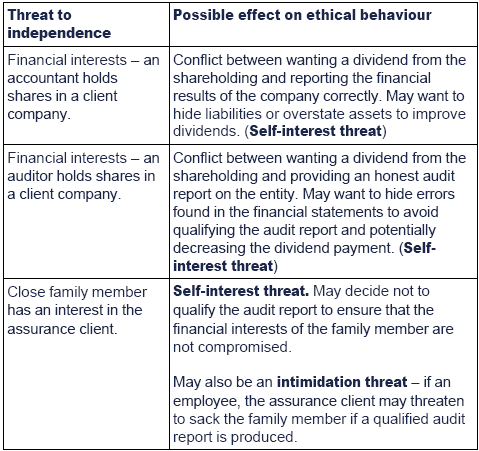

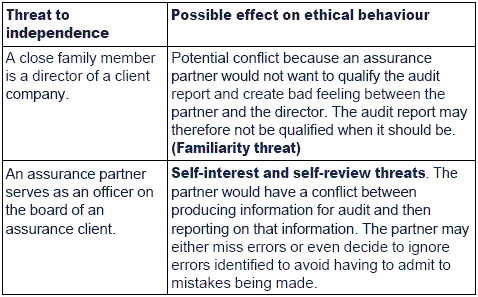
Conceptual framework
A conceptual framework can be explained as follows:
- It provides an initial set of assumptions values and definitions which are agreed upon and shared by all those subject to the framework.
- It is stated in relatively general terms so it is easy to understand and communicate.
- It recognises that ethical issues may have no 'correct' answer and therefore provides the generalised guidelines and principles to apply to any situation.
Safeguards
Safeguards seek to reduce or eliminate threats. They fall into three categories created by the:
Profession
These include:
- education and training including CPD requirements
- setting of corporate governance regulations and professional standards
- monitoring of professional work including disciplinary proceeding
Work environment
There are many examples which include:
- internal control systems
- review procedures
- disciplinary procedures
- organisational codes of ethics
- separate review and reporting for key engagements.
Individual
These include:
- complying with professional standards
- maintaining records of contentious issues
- mentoring
- contacting professional bodies with queries.
Ethical threats and safeguards
An ethical threat is a situation where a person or corporation is tempted not to follow their code of ethics.
- An ethical safeguard provides guidance or a course of action which attempts to remove the ethical threat.
- Ethical threats apply to accountants - whether in practice or business.
- The safeguards to those threats vary depending on the specific threat.
- The professional accountant must always be aware that fundamental principles may be compromised and therefore look for methods of mitigating each threat as it is identified.
Examples of ethical threats and safeguards
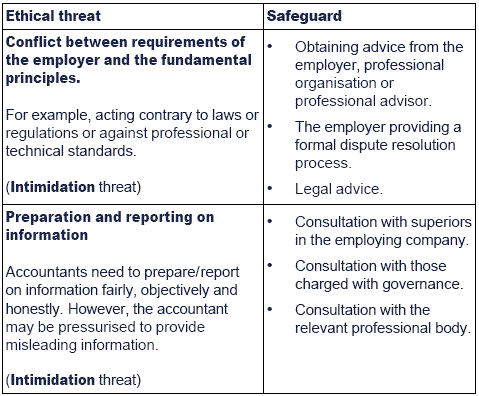
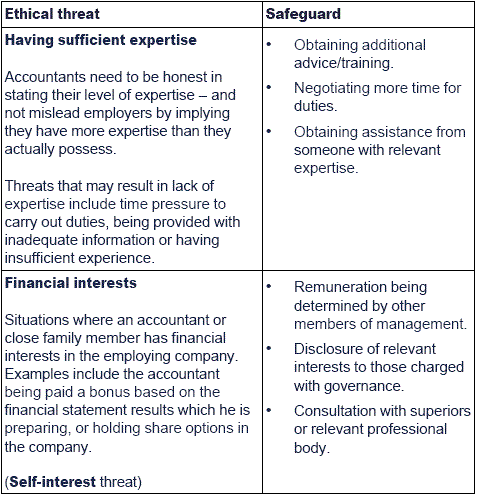
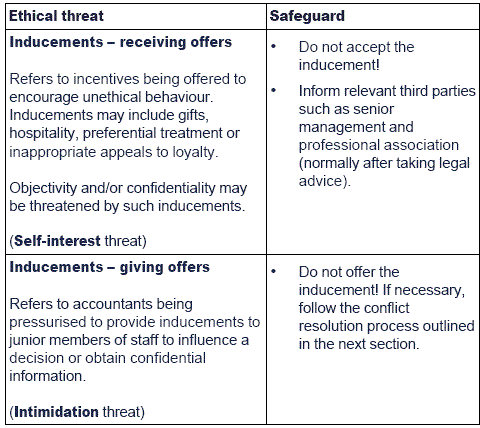

Ethical dilemmas and conflict resolution
Rules- and principles-based approaches
- Most professional institutes use a principles-based approach to resolving ethical dilemmas.
- Use of a rules-based approach is normally inappropriate as rules cannot cover every eventuality.
Rules- and principles-based approaches
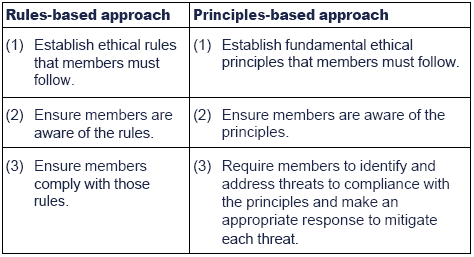
Rules-based approach
Benefits:
- Easy to check compliance as based on fact.
- Easy to amend rule set as required.
Disadvantages:
- The list of rules may not be complete.
- There is no room for individual decision making.
Principles-based approach
Benefits:
- Recognises that every threat cannot simply be 'listed'.
- Allows for subjective judgement, so the member can apply the principles in accordance with their specific situation and nature of the threat.
Disadvantages:
- In some situations it may be difficult to confirm that the compliance action was appropriate as two people may make different and valid decisions based on the same threat and circumstances.
Ethical conflict resolution
Ethical conflicts can be resolved as follows:
Note that the diagram provides only one method of thinking through an ethical situation. The diagram reminds you that there are many areas to take into account in ethical decision making, but the structure of making that decision may not always be this clear.
|
Created at 10/2/2012 8:57 PM by System Account
(GMT) Greenwich Mean Time : Dublin, Edinburgh, Lisbon, London
|
Last modified at 9/27/2013 3:45 PM by System Account
(GMT) Greenwich Mean Time : Dublin, Edinburgh, Lisbon, London
|
|
|
|
 |
Rating
:
|
 Ratings & Comments
(Click the stars to rate the page) Ratings & Comments
(Click the stars to rate the page)
|
 |
Tags:
|
|
|
|
|